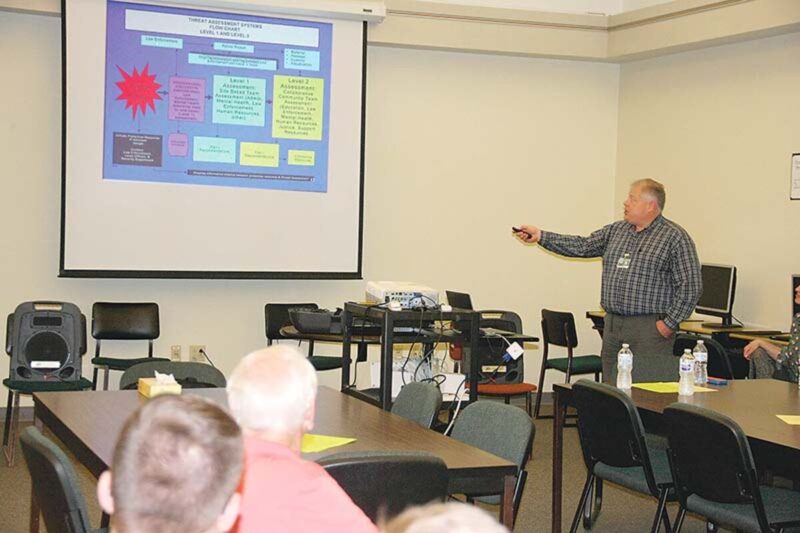Sean C. Morgan
The Sweet Home School District and Sweet Home Police Department have two different programs to deal with real or imagined threats that arise in local schools, attendees at the district’s first Community Connections forum learned last week.
The district hosted its first Community Connections forum May 16 in the high school library to answer questions and provide information to community members regarding how the district and police work together to keep schools safe and welcoming.
The event took place the night before a school shooting in the Houston, Texas, area and a lockdown at Lebanon High School and other schools in Lebanon on Friday morning as police searched for a student who was reported to have a gun.
In addition to learning about the district’s response to threats, participants at the Sweet Home forum were told how the district is in the process of securing its elementary and junior high schools.
Sweet Home High School Vice Principal Mark Looney said the district uses a program created in the Salem-Keizer School District that is being implemented around the nation for threat assessment.
The district has a Student Threat Assessment Team, Looney said. Six school officials are trained in the program.
The goals of the threat assessment system are to assess threats of potentially harmful or lethal behaviors and to determine the level of concern and action required; to organize resources and strategies to manage situations involving students that pose threats to other students or staff; and to maintain a psychological safety among students, teachers and parents.
Looney displayed a flow chart outlining how officials would respond to an “incident of concern.”
The first step is immediate protective response to an imminent danger, with school officials contacting law enforcement. If danger is not imminent, then professionals from the district, law enforcement and mental health services discuss the incident and determine the need for “site-based assessment.”
The incident may be considered unfounded at that point or the professionals will begin a site-based team assessment, At level 1, the team develops a plan to address the concern. The team may report the incident to law enforcement.
The team develops a plan to protect victims, and parents are notified. The team interviews the student(s) involved and student witnesses. It also provides a questionnaire to parents and staff.
If the team cannot resolve the situation, it moves to level 2.
At level 2, a collaborative community team is formed at the Education Service District level, including officials from education, law enforcement, mental health, human resources, justice and support resources. The team follows a similar investigation process and then develops a recommendation and a plan involving community-wide resources.
The plan may involve a police report along with custody and referral on specific charges and adjudication.
The teams must determine what type of aggression was involved, Looney said. Aggression may be categorized as reactive or targeted and predatory. The action may be ranked on a spectrum of behaviors ranging in seriousness from pushing and slapping to shooting or bombing.
“We also have to maintain confidentiality,” Looney said. “We can’t just tell you what’s gong on.”
The district can share information with appropriate officials in health and safety emergencies and to comply with lawfully issued judicial orders.
Looney listed three ways people can help the STAT teams: by contacting school officials, law enforcement or SAFE Oregon, which operates an anonymous tip line.
He and Thad Holub, director of Student Servics for the district, said the assessment process has been used about four times at the high school and nearly 20 times across the district this year. Exact numbers were not immediately available, they said.
Mostly incidents ended up being minor and were not considered a “founded” threat, Holub said.
When danger is imminent, schools and law enforcement use the Standard Response Protocol, a program created by the I Love You Guys Foundation in Central Oregon in 2009.
Sweet Home has been using the program for four years, said Geoff Hamlin, school resource officer.
The program responds to emergencies with one of four actions: lockout, lockdown, evacuate and shelter. The actions are listed on posters throughout district buildings.
In a lockout, schools secure their perimeter, Hamlin said. Police may call for a lockout when something dangerous is near a school. In the case of a nearby bank robbery in 2012 at Umpqua Bank, that’s how the School District responded.
No one is allowed in or out of a school facility in lockout, but students continue with business as usual.
In a lockdown, schools and classrooms are locked, with lights out and students hiding silently out of sight of the corridor window, Hamlin said. Students are not to open the door for anyone.
Schools enter lockdown when something dangerous is inside the building, Hamlin said.
In the third response, officials may evacuate children, lining them up to be led by teachers, Hamlin said. People at intersections direct them to their evacuation site.
Parents are notified where to pick up their children, Hamlin said. They should bring identification.
Self-evacuation is an option for children who cannot get behind a locked door in a lockdown, Hamlin said. The student should let an adult know where he or she is.
For hazards, such as an earthquake, students may shelter in the school.
Sweet Home schools have one more action, a “hold” action,” Hamlin said. Under a hold, during a medical emergency, for example, halls are kept clear and students remain in their classrooms.
The public can help by remaining calm and staying clear of the area, Hamlin said. The public should communicate anything suspicious to law enforcement and be prepared to follow directions.
Referring to the recent Parkland High School shooting in Florida, Police Chief Jeff Lynn said there were a lot of red flags that, with what Sweet Home has implemented, can be addressed.
Among the precautions in Oregon is SAFE Oregon, an anonymous tip line set up by the Oregon State Police, Lynn said. Almost 500 schools signed up for it last year.
Many people don’t report incidents because they fear retaliation, Lynn said. This can help alleviate that concern.
“It’s already been implemented in Oregon, and there’s been a number of times it’s prevented threats on campuses,” he said.
Supt. Tom Yahraes said it will be available in Sweet Home this week. For more information visit safeoregon.com. Tips may be submitted by email to [email protected], by calling or texting (844) 472-3367, through a mobile app or through the website.
Through the voter-approved bond next year, the district is adding security improvements to school buildings. Each elementary school and the junior high will have a “safety vestibule,” accessible using a card-lock system or by pushing a button in the office.
Oak Heights already has one, paid for by the Parent-Teacher Club. They will be installed at Foster, Hawthorne, Holley and SHJH.
Students at the junior high will all be in a single building, with secure entrances after its renovation is completed in 2019, Yahraes said.
The district is adding security cameras across the district and enhancing communication systems, including phone, email and blasts, he said. It is reviewing safe routes to schools and upgrading transportation routes.
The district is in the process of spending $6.5 million in grant funds on seismic upgrades to help protect lives in case of an earthquake, Yahraes said.
Long range, the district will continue to work on new ways to improve security at the high school, Yahraes said. He said the school is a 1970s California-style open campus, which is problematic.
“I would love to have a much less free access for my children,” said Principal Ralph Brown, who has two students at Sweet Home High School.
Looney said the school has been and continues to improve its surveillance system at this point and would love restricted access down the road. During the day, the school has some doors locked. He also noted that some people want to avoid having it look like a prison.
The May 16 forum also outlined how school officials deal with bullying and conflict among students.
Approximately a dozen members of the public and staff who were not related to the presentation attended the Community Connections forum.
Yahraes is planning additional forums in the future on a variety of topics.





